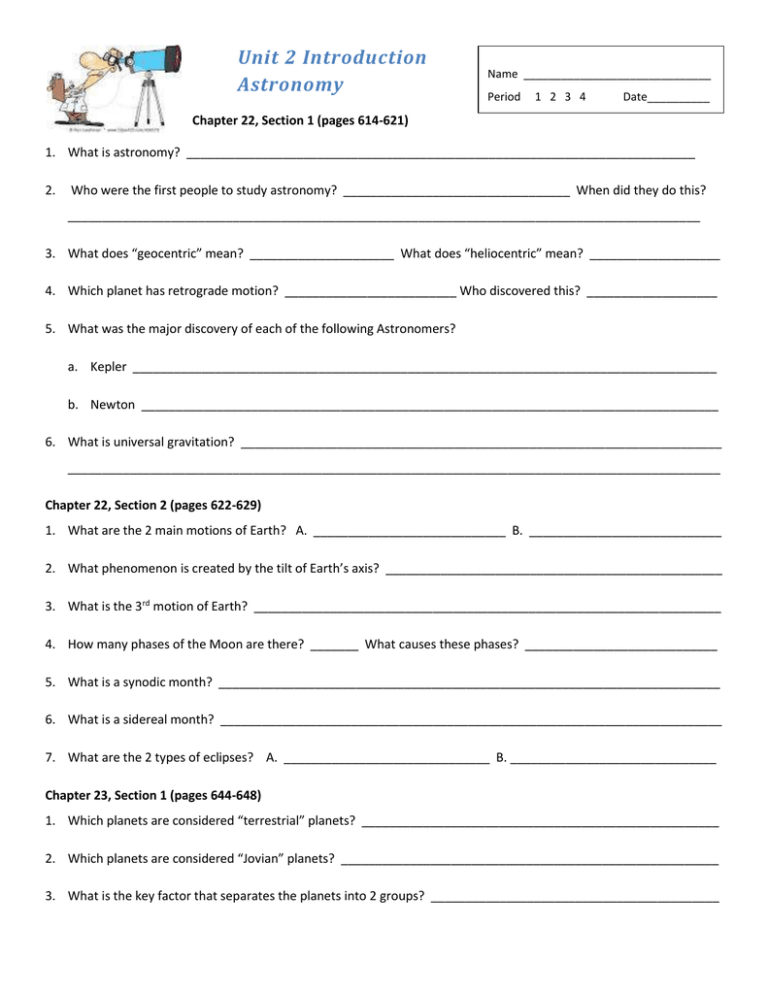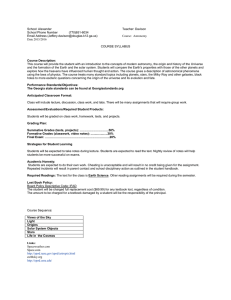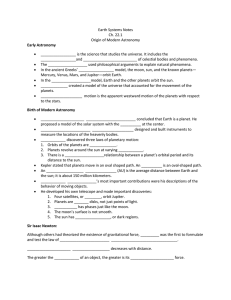Unit 2 Introduction
advertisement

Unit 2 Introduction Astronomy Name ______________________________ Period 1 2 3 4 Date__________ Chapter 22, Section 1 (pages 614-621) 1. What is astronomy? __________________________________________________________________________ 2. Who were the first people to study astronomy? _________________________________ When did they do this? ____________________________________________________________________________________________ 3. What does “geocentric” mean? _____________________ What does “heliocentric” mean? ___________________ 4. Which planet has retrograde motion? _________________________ Who discovered this? ___________________ 5. What was the major discovery of each of the following Astronomers? a. Kepler _____________________________________________________________________________________ b. Newton ____________________________________________________________________________________ 6. What is universal gravitation? ______________________________________________________________________ _______________________________________________________________________________________________ Chapter 22, Section 2 (pages 622-629) 1. What are the 2 main motions of Earth? A. ____________________________ B. ____________________________ 2. What phenomenon is created by the tilt of Earth’s axis? _________________________________________________ 3. What is the 3rd motion of Earth? ____________________________________________________________________ 4. How many phases of the Moon are there? _______ What causes these phases? ____________________________ 5. What is a synodic month? _________________________________________________________________________ 6. What is a sidereal month? _________________________________________________________________________ 7. What are the 2 types of eclipses? A. ______________________________ B. ______________________________ Chapter 23, Section 1 (pages 644-648) 1. Which planets are considered “terrestrial” planets? ____________________________________________________ 2. Which planets are considered “Jovian” planets? _______________________________________________________ 3. What is the key factor that separates the planets into 2 groups? __________________________________________ 4. Explain the Nebular Theory ________________________________________________________________________ _______________________________________________________________________________________________ 5. What is a planetesimal? __________________________________________________________________________ Chapter 23, Section 2 (pages 649-653) 1. What makes Mercury different from all other planets? __________________________________________________ 2. What natural activities occur on Venus that is similar to those on Earth? ___________________________________ 3. What kinds of storms occur on Mars? _______________________________________________________________ 4. Which of these planets is known to have water? _______________________________________________________ Chapter 23, Section 3 (pages 654-659) 1. What property makes Jupiter different from all other planets? ___________________________________________ 2. What is Saturn best known for? ____________________________________________________________________ 3. What makes Uranus different? _____________________________________________________________________ 4. What makes Neptune different? ____________________________________________________________________ 5. How is Pluto’s orbit different from the other planets? __________________________________________________ _______________________________________________________________________________________________ a. Pluto is no longer considered a planet- what do you think? Give a thorough explanation. ________________________________________________________________________________________ ________________________________________________________________________________________ ________________________________________________________________________________________ ________________________________________________________________________________________ Unit 2 Introduction Astronomy Name Answer Key Period 1 2 3 4 Date__________ Chapter 22, Section 1 (pages 614-621) (2 points each) 1. What is astronomy? 2. The study of space and Earth’s neighbors in space Who were the first people to study astronomy? 3. What does “geocentric” mean? Greeks When did they do this? 600 BC – 150 AD The Earth is the center of the Solar System What does “heliocentric” mean? The Sun is the center of the Solar System 4. Which planet has retrograde motion? Mars Who discovered this? Ptolemy 5. What was the major discovery of each of the following Astronomers? a. Kepler Discovered 3 laws of planetary motion b. Newton First to formulate and test the law of universal gravitation 6. What is universal gravitation? Each object in the Universe has gravity which attracts other objects towards it and the amount of gravity exerted on an object is based on its mass Chapter 22, Section 2 (pages 622-629) 1. What are the 2 main motions of Earth? A. Rotation B.Revolution 2. What phenomenon is created by the tilt of Earth’s axis?Earth’s seasons 3. What is the 3rd motion of Earth? Precession 4. How many phases of the Moon are there? 8 What causes these phases? The orbiting of the moon around Earth 5. What is a synodic month? The time it takes between two successive full moons (29.5 days) 6. What is a sidereal month? The time it takes the moon to make a full revolution around Earth (27.3 days) 7. What are the 2 types of eclipses? A. Solar B. Lunar Chapter 23, Section 1 (pages 644-648) 1. Which planets are considered “terrestrial” planets? Mercury, Venus, Earth, Mars 2. Which planets are considered “Jovian” planets? Saturn, Jupiter, Uranus, Neptune 3. What is the key factor that separates the planets into 2 groups? Size & Composition 4. Explain the Nebular Theory Materials that form the planets was revolving around the Sun; these objects collided with one another, forming larger objects until the planets were formed 5. What is a planetesimal? A small planet (early form) Chapter 23, Section 2 (pages 649-653) 1. What makes Mercury different from all other planets? Closest to the Sun & hottest 2. What natural activities occur on Venus that is similar to those on Earth? Volcanism 3. What kinds of storms occur on Mars? Dust storms 4. Which of these planets is known to have water? Mars Chapter 23, Section 3 (pages 654-659) 1. What property makes Jupiter different from all other planets? It is the largest (at least 2x the mass of all other planets combined) 2. What is Saturn best known for? Its rings system 3. What makes Uranus different? Its axis has been turned sideways 4. What makes Neptune different? Its orbit causes Neptune to orbit outside of Pluto’s orbit 5. How is Pluto’s orbit different from the other planets? Pluto’s orbit is longer and narrower than the other planets’ orbits Unit 2 Introduction Astronomy Name ______________________________ Period 1 2 3 4 Date__________ Chapter 22, Section 1 (pages 614-621) 1. ¿Qué esastronomy? ________________________________________________________ 2. ¿Quiénes fueronlas primeras personas enestudiar astronomy? ____________________ Grade _________% Score ________/44 Cuandohicieron esto?_______________________________________________________ 3. ¿Quésignificaba“geocentric”? _____________________ ¿Quésignificaba“heliocentric”? ___________________ 4. ¿Qué planetatiene un retrograde motion? ______________________ ¿Quién descubrióesto? ________________ 5. ¿Cuál fue elmayor descubrimientodecada uno de losastrónomossiguientes? a. Copernicus _________________________________________________________________________________ b. Brahe _____________________________________________________________________________________ c. Kepler _____________________________________________________________________________________ d. Galileo ____________________________________________________________________________________ e. Newton ___________________________________________________________________________________ 6. ¿Qué es universal gravitation? ____________________________________________________________________ ______________________________________________________________________________________________ Chapter 22, Section 2 (pages 622-629) 1. ¿Cuáles son losdosprincipalesmovimientosde la Tierra?A. ____________________ B. ___________________ 2. ¿Qué fenómenoes creado porla inclinación del ejede la Tierra?_________________________________________ 3. ¿Quées el movimientoterciode la Tierra?___________________________________________________________ 4. ¿Cuántasfases de la Lunahay?__________ ¿Quéhace que estasfases? __________________________________ 5. ¿Qué es una synodic month? _____________________________________________________________________ 6. ¿Qué es unasidereal month? _____________________________________________________________________ 7. ¿Cuáles son losdostiposde eclipse? A. _____________________________ B. ____________________________ Chapter 22, Section 3 (pages 630-634) 1. ¿Qué es una crater? ____________________________________________________________________________ 2. ¿Quées la teoríamás aceptadasobre cómo laluna fue creada?__________________________________________ ______________________________________________________________________________________________ Chapter 23, Section 1 (pages 644-648) 1. ¿Qué planetasson consideradosplanetas "terrestrial"?________________________________________________ 2. ¿Qué planetasson considerados como "Jovian" planetas?______________________________________________ 3. ¿Cuál esel factor clave quesepara a losplanetasen 2 grupos? __________________________________________ 4. Explicar el Nebular Theory _______________________________________________________________________ ______________________________________________________________________________________________ 5. ¿Qué es unplanetesimal? ________________________________________________________________________ Chapter 23, Section 2 (pages 649-653) 1. ¿Lo que hacediferente a todosMercuryotros planetas? _______________________________________________ 2. ¿Qué actividadesnaturales ocurrenen Venusque es similar alas de la Tierra?______________________________ 3. ¿Qué tipo detormentasse producenen Mars?_______________________________________________________ 4. ¿Cuál deestos planetasse sabe que tieneel agua? ____________________________________________________ Chapter 23, Section 3 (pages 654-659) 1. ¿Québien hace deJúpiterdiferente de todos losotros planetas?_________________________________________ 2. ¿Qué esmejor conocido porSaturn? ________________________________________________________________ 3. Lo que hacediferenteUranus?_____________________________________________________________________ 4. Lo que hacediferenteNeptune?___________________________________________________________________ 5. ¿Cómo esla órbita de Plutodiferente de losotros planetas?____________________________________________ ______________________________________________________________________________________________ Chapter 23, Section 4 (pages 660-664) 1. ¿Dóndeestánla mayoría de losasteroidessituadoen el SistemaSolar?____________________________________ 2. Identificar las partes deun cometa._________________________________________________________________ 3. Enlos cuales 2lugares en elSistemaSolar sonlos cometasse encuentranen órbita?_________________________ 4. Quecometaes más conocidopara nosotros?_________________________________________________________ 5. ¿Cuáles sonlas diferencias entre un"meteoroid", un "meteor", y un "meteorite"?___________________________ ______________________________________________________________________________________________ Vocabulario -Definircada una de laspalabrassiguientes. Astronomy Precession Terrestrial Planet Coma Geocentric Perihelion Jovian Planet Meteoroid Heliocentric Aphelion Nebula Meteor Retrograde Motion Perigee Planetesimal Meteorite Rotation Apogee Asteroid Revolution Crater Comet







